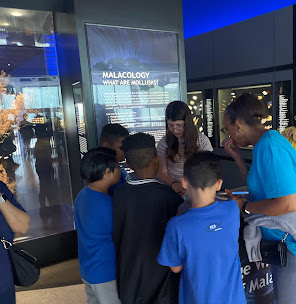Day 3: Sorting the Shells
Since the professor wasn't here, I spent today putting what I learned these last few days into practice.



This is a bivalve, and, according to the book, is shaped like a "fan." From there, it looked like it belonged to the "spondylidae" family. I checked with the labels to the side of the exhibit, and that was correct! So, the moral of this: taxonomy is harder than it looks...
Unfortunately I found out this morning that he was busy with another class, and would only be free later in the afternoon, but by that point I would have already left the museum. So, I figured that I could still try my hand at some beginner practical work, one which wouldn't require his assistance: classifying mollusks.
I found out that he might be busy until Friday, where he should be having the morning free to show me the resources he wanted to discuss. Until then, Ms. Leap suggested that I have a go with seeing some of the fossils and mollusks he uses to teach in the office I entered on Monday. There, while some fossils and specimens were closed in plastic containers, others were not and some did not even have labels.
So, we took one small open container with hand-sized mollusks, and these were not labelled. After confirming that they were not unauthorised to use, we set aside the container, I grabbed one of the books, "Shells" by S. Peter Dance, a guide to identifying shells.
I took it to the malacology exhibit, the one I visited on Monday, and started trying to apply the steps there before going in hands-on.
Luckily, there wasn't much reading, since the book was filled with pictures and annotations rather than paragraphs or the such; more of a manual, if you will. All I had to make sure that I understood was the two main stages, and the rest was simply scrolling through the book until you found a match.
The first step of identification is to see what class it is. I've already mentioned this on the entry from Monday, but most living mollusks belong to the gastropod class, bivalves are the second largest class, and cephalopods, tusk shells, and chitons are minor classes.
Once, that is sorted, you see what shape that shell has. (This is more in general terms, like a "fan" or "pear" or "club.")
Then, the shape you most closely linked it to gives you multiple options to further narrow it down. From there it is mainly following the index to different pages, where the name, picture, features, and facts of that shell are given. If it's the shell you have, great. If not, try again.
In the malacology exhibit, I chose one of the shells I really liked, and used the steps I just mentioned to first practice naming it.



This is a bivalve, and, according to the book, is shaped like a "fan." From there, it looked like it belonged to the "spondylidae" family. I checked with the labels to the side of the exhibit, and that was correct! So, the moral of this: taxonomy is harder than it looks...
After I was done with that, I went back to the office, got to selecting a few shells, and started trying to narrow down their families.
Honestly the hardest part was the fact that all of the shells were gastropods, and at least three were really similar but had small unique features which made it hard to differentiate them... but alas I finished that in time.
Lastly, Ms. Leap also offered if I would consider trying, sometime during M-Term, to present to visitors the "touch carts," which are basically open exhibits which guests can touch. Usually in these types of presentations, the presenter will study a selected amount of objects in the cart, and would explain them to the audience. Obviously, the objects in the carts are important, but they are not the indispensable specimens that are usually behind glass, so the museum won't absolutely freak-out if they're damaged (but still let's not break anything).
That sounded like a fun and challenging idea, and I was immediately drawn to it. I could participate in these events while I wait for Mr. Washington to be available. So, tomorrow I will be touring with Ms. Leap around either the malacology or paleontology exhibits to see which carts are free for me to choose some objects, and then I'll be back to researching and learning about those, to hopefully be ready to present them.
... but more on that tomorrow!




Comments
Post a Comment